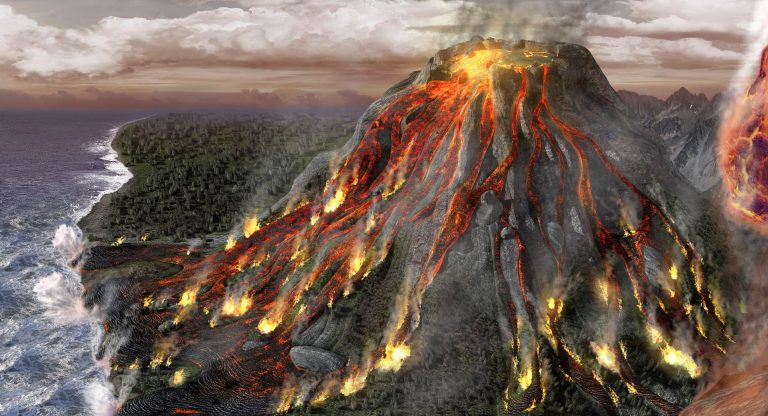Part:
Some of the recent volcanoes of the world are
- Piton de la Fournaise is a massive basaltic shield volcano on the French island of Réunion in the western Indian Ocean. Recent volcanism is characterized by multiple fissure eruptions, lava fountains, and lava flows (BGVN 44:11). The activity during this reporting period of November 2019-April 2020 is consistent with the previous eruption, including lava fountaining and lava flows
- Karymsky is an active volcano, part of Kamchatka’s eastern volcanic zone. Eruptive activity has been frequent since 1996 and has included ash explosions, gas-and-steam and ash emissions, and thermal anomalies.
- The fissure eruption in the W part of the Krýsuvík-Trölladyngja volcanic system, close to Fagradalsfjall on the Reykjanes Peninsula, continued during 11-18 May. The lava effusion rate was 10.8 meters per second, lower than the 12.9 meters per second rate recorded
- Semisopochnoi is a remote stratovolcano located in the western Aleutians dominated by an 8 km-wide caldera containing the small (100 m diameter) Fenner Lake and a three-cone cluster: a northern cone known as the North cone of Mount Cerberus, an eastern cone known as the East cone of Mount Cerberus, and a southern cone known as the South cone of Mount Cerberus.
- A massive stratovolcano in easternmost Java, Raung has over sixty recorded eruptions dating back to the late 16th Century. Explosions with ash plumes, Strombolian activity, and lava flows from a cinder cone within the 2-km-wide summit crater have been the most common activity
- Merapi, located just north of the city of Yogyakarta, Indonesia, is a highly active stratovolcano; the current eruption began in May 2018. Volcanism has recently been characterized by lava dome growth and collapse, small block-and-ash flows, explosions, ash plumes, ashfall, and pyroclastic flows crater in December 2020
- Soufrière St. Vincent is the northernmost stratovolcano on St. Vincent Island in the southern part of the Lesser Antilles. The NE rim of the 1.6-km-wide summit crater is cut by a crater (500 m wide and 60 m depth) that formed in 1812. Recorded eruptions date back to 1718, with notable eruptions occurring in 1812, 1902, and 1979. The eruption of 1979 was characterized by ashfall, pyroclastic flows, and lahars, in addition to a series of Vulcanian explosions during 13-26 April 1979 that destroyed the lava dome in the summit crater, which had formed during a 1971 effusive eruption
- Kilauea’s East Rift Zone (ERZ) has been intermittently active for at least two thousand years. Since the current eruptive period began in 1983 there have been open lava lakes and flows from the summit caldera and the East Rift Zone. A marked increase in seismicity and ground deformation at Pu’u ‘O’o cone on the upper East Rift Zone
- Lewotolok (also known as Lewotolo) is located on the eastern end of a peninsula connected to Lembata (formerly Lomblen) that extends north into the Flores Sea. Eruptions date back to 1660, characterized by explosive activity in the summit crater. Typical activity has consisted of seismicity and thermal anomalies near the summit crater
- Kavachi is an active submarine volcano in the SW Pacific, located in the Solomon Islands south of the Gatokae and Vangunu islands. Volcanism has been characterized by phreatomagmatic explosions that ejected steam, ash, and incandescent bombs.
- Indonesia’s Sinabung volcano in northern Sumatra has been highly active since its first confirmed Holocene eruption during August and September 2010. It remained quiet after the initial eruption until September 2013, when a new eruptive phase began that continued through June 2018. A summit dome emerged in late 2013 and produced a large lava “tongue” during 2014. Multiple explosions produced ash plumes, block avalanches, and deadly pyroclastic flows during the eruptive period.
- Sarychev Peak, located on Matua Island in the central Kuril Islands of Russia, has had eruptions reported since 1765. Renewed activity began in October 2017, followed by a major eruption in June 2009 that included pyroclastic flows and ash plumes.
- Sangay is one of the most active volcanoes in Ecuador with the current eruptive period continuing since 26 March 2019. Activity at the summit crater has been frequent since August 1934, with short quiet periods between events. Recent activity has included frequent ash plumes, lava flows, pyroclastic flows, and lahars.
- Tinakula is located 100 km NE of the Solomon Trench at the N end of Santa Cruz. The current eruption began in December 2018 and has recently been characterized by intermittent small thermal anomalies and gas-and-steam plumes (BGVN 45:07), which continued into the current reporting period of July-December 2020.
- Karangetang (also known as Api Siau) is located on the island of Siau in the Sitaro Regency, North Sulawesi, Indonesia and consists of two active summit craters: a N crater (Kawah Dua) and a S crater (Kawah Utama, also referred to as the “Main Crater”). More than 50 eruptions have been observed since 1675.
- Barren Island is a remote island east of India in the Andaman Islands. Its most recent eruptive period began in September 2018 with volcanism characterized by thermal anomalies and small ash plumes

